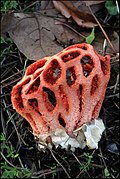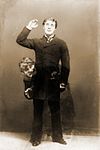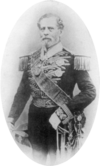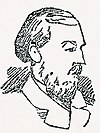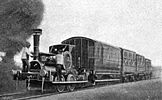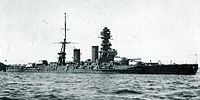
Back Šablon:Istaknuti članak/maj2017 BS Wikipédia:Lumière sur/Mai 2017 French Wikipedia:Bài viết chọn lọc/2017/05 Vietnamese Wikipedia:典范条目/2017年5月 Chinese
| << | Today's featured articles for May 2017 | >> | ||||
|---|---|---|---|---|---|---|
| Su | Mo | Tu | We | Th | Fr | Sa |
| 1 | 2 | 3 | 4 | 5 | 6 | |
| 7 | 8 | 9 | 10 | 11 | 12 | 13 |
| 14 | 15 | 16 | 17 | 18 | 19 | 20 |
| 21 | 22 | 23 | 24 | 25 | 26 | 27 |
| 28 | 29 | 30 | 31 | |||
May 1
Clathrus ruber, the red cage fungus, is a species in the stinkhorn family. The pink, orange or red fruit bodies form interlaced branches in the shape of a round or oval hollow sphere. The fungus is saprobic, feeding off decaying woody plant material, and is usually found in leaf litter on garden soil, grassy places, or woodchip garden mulches. Primarily a European species, C. ruber has been introduced to northern Africa, Asia, Australia, and North and South America. The fruit body is initially white and egg-shaped, attached to the ground by mycelial cords. It has a delicate, leathery outer membrane enclosing the compressed lattice that surrounds a layer of olive-green spore-bearing slime called the gleba. As the egg ruptures and the fruit body expands, the gleba is carried upward on the inner surfaces of the spongy lattice, and the egg membrane remains as a volva at the base. The gleba smells like rotting meat, which attracts flies and other insects that carry off its spores. The fungus's edibility is unknown, but its odor would deter most from consuming it. (Full article...)
May 2
James Moore (c. 1737 – 1777) was a Continental Army general during the American Revolutionary War. Born into a prominent political family in the lower Cape Fear River area of North Carolina, he was one of only five Continental Army generals from the state. He served in the colonial militia during the French and Indian War, and commanded the colonial governor's artillery at the Battle of Alamance, which ended the War of the Regulation. In the independence movement, Moore played a prominent role in the local Sons of Liberty organizations, and assisted in organizing the colony-wide Provincial Congress. In 1775, he was elected the first commander of a Continental Line regiment in North Carolina, which had been raised following the instructions of the Continental Congress. After distinguishing himself in the campaign that led to the Patriot victory at the Battle of Moore's Creek Bridge in February 1776, Moore was promoted to brigadier general in the Continental Army. He held de facto command of the Southern Department before his death due to illness. (Full article...)
May 3
Temperatures Rising is an American television sitcom that aired on the ABC network with 46 episodes from September 1972 to August 1974. It was developed by William Asher and Harry Ackerman. The first season, set in a fictional Washington, D.C. hospital, featured James Whitmore as a no-nonsense chief-of-staff who endures the antics of a young intern (Cleavon Little) and three nurses (Joan Van Ark, Reva Rose, and Nancy Fox). In the 13-episode second season, produced by Duke Vincent and Bruce Johnson, everyone except Little was replaced, and the show was retitled The New Temperatures Rising Show. Comedian Paul Lynde played a penny-pinching chief-of-staff, accompanied by Sudie Bond, Barbara Cason, Jennifer Darling, Jeff Morrow, and John Dehner. Critics preferred the second-season cast, but the black comedy approach led to lower ratings. In an unsuccessful seven-episode summer revival of the series, Asher returned as producer and restored the series to its original format and title, retaining Paul Lynde in the lead, with a cast of Little, Fox, Alice Ghostley and Barbara Rucker. (Full article...)
May 4
The Battle of the Coral Sea (4–8 May 1942) was the first battle of World War II in which the Allies were able to stop a major advance of the Imperial Japanese Navy. Japanese forces, including two fleet carriers and a light carrier, had orders to invade and occupy Port Moresby in New Guinea and Tulagi in the southeastern Solomon Islands. The US intercepted their communications, and sent two carrier task forces and a joint Australian–American cruiser force to stop them. On 3–4 May Japanese forces took Tulagi, although several of their supporting warships were sunk or damaged by aircraft from the US carrier Yorktown. On 7–8 May the opposing carrier forces exchanged airstrikes in the Coral Sea. Yorktown was damaged, and the USS Lexington was scuttled (explosion pictured). After the loss of the Japanese carrier Shōhō and heavy damage to Shōkaku, the Port Moresby invasion was scrapped, and never reattempted. The Japanese losses led to a greater loss a month later at the Battle of Midway, where all four of their large aircraft carriers were sunk. Two months later, the Allies launched the Guadalcanal Campaign, hastening Japan's ejection from the South Pacific. (Full article...)
May 5

Wolfenstein 3D is a first-person shooter video game developed by id Software, published by Apogee Software and FormGen, and originally released on May 5, 1992, for MS-DOS. Its innovative, ray casting-based game engine (illustration shown) was designed by John Carmack. The player assumes the role of Allied spy William "B.J." Blazkowicz during World War II as he escapes from the Nazi German prison Castle Wolfenstein and carries out a series of crucial missions against the Nazis. Wolfenstein 3D was the second major release by id Software, and was released through Apogee in two sets of three episodes as shareware; the first episode was available free of charge, to drive interest in purchasing the rest. An additional episode, Spear of Destiny, was released as a standalone retail title through FormGen. Wolfenstein 3D was a critical and commercial success, garnering numerous awards and selling over 200,000 copies by the end of 1993. The game popularized the first-person shooter genre, established standards of fast-paced action and technical prowess for subsequent games in the genre, and showcased the viability of the shareware publishing model. (Full article...)
May 6
Saint Luke Drawing the Virgin is a large 15th-century panel painting, oil and tempera on oak, attributed to the Early Netherlandish painter Rogier van der Weyden and usually dated between 1435 and 1440. Housed in the Museum of Fine Arts, Boston, it shows Luke the Evangelist, patron saint of artists, sketching the Virgin Mary as she nurses the Child Jesus. The figures are positioned in a bourgeois interior which leads out towards a courtyard, river, town and landscape. The enclosed garden, illusionistic carvings of Adam and Eve on the arms of Mary's throne, and attributes of St Luke are amongst the painting's iconographic symbols. The face of Luke is accepted as van der Weyden's self-portrait. The painting's historical significance rests on both the skill behind the design and its merging of earthly and divine realms. By positioning himself in the same space as the Madonna, and showing a painter in the act of portrayal, Van der Weyden brings to the fore the role of artistic creativity in 15th-century society. The panel became widely influential with near copies by the Master of the Legend of Saint Ursula and Hugo van der Goes. (Full article...)
May 7
Subtropical Storm Andrea was the first named storm and first subtropical cyclone of the 2007 Atlantic hurricane season. Six people drowned as a result of the storm. It arose out of an extratropical storm that attained hurricane-force winds on May 7, three and a half weeks before the official start of the hurricane season. A non-tropical low developed two days later about 150 miles (240 km) northeast of Daytona Beach, Florida. It weakened to a subtropical depression the next day while remaining nearly stationary, and the National Hurricane Center discontinued advisories early on May 11. Andrea was the first pre-season storm since Tropical Storm Ana in April 2003 and the first Atlantic named storm in May since Tropical Storm Arlene in 1981. The storm produced rough surf along the coastline from Florida to North Carolina, causing beach erosion and some damage. In some areas, the waves eroded up to 20 feet (6 m) of beach, leaving 70 homes in danger of collapse. Off North Carolina, high waves of 34 feet (10 m) and tropical-storm-force winds damaged three boats; their combined nine passengers sustained injuries before being rescued by the Coast Guard. (Full article...)
May 8
The white-rumped swallow (Tachycineta leucorrhoa) is a species of bird, the only one in its genus, in the family Hirundinidae. First described and given its scientific name by French ornithologist Louis Vieillot in 1817, it has no known population variations. It is black from the eyes to the nostrils, with a white streak just above. The ear coverts, tail, and wings are black, with white tips on the wings. The rest of the upperparts are a glossy blue. Its underparts and underwing-coverts are white, in addition to the rump, as the name suggests. It usually builds its nest in holes in trees or dead snags, and sometimes under eaves or in holes in fence posts. This swallow is found in Argentina, Bolivia, Brazil, Paraguay, Peru, and Uruguay. Its natural habitats are dry savanna, pastureland, the edge of forests, and subtropical or tropical seasonally wet or flooded lowland grassland. It is classified as a species of least concern by the International Union for Conservation of Nature. Its population is increasing, partly because of the increase in availability of man-made structures suitable for nest sites. (Full article...)
May 9
Dr. Jekyll and Mr. Hyde is a four-act play written by Thomas Russell Sullivan in collaboration with the actor Richard Mansfield (pictured). It is an adaptation of Strange Case of Dr Jekyll and Mr Hyde, an 1886 novella by Robert Louis Stevenson. The story focuses on the respected London doctor Henry Jekyll, who uses a potion to transform into Edward Hyde, a loathsome criminal. Intrigued by the opportunity to play a dual role, Mansfield secured the stage rights and asked Sullivan to write the adaptation. The play debuted in Boston on May 9, 1887, then opened on Broadway in September of that year. Mansfield's performance as the dual character was acclaimed by critics. The play opened in London in August 1888, just before the first Jack the Ripper murders. Some press reports compared the murderer to the Jekyll-Hyde character, and Mansfield was suggested as a possible suspect. Mansfield's company continued to perform the play in the US until shortly before his death in 1907. Sullivan made changes from Stevenson's story that have been adopted by many subsequent adaptations, including several film versions that were derived from the play. (Full article...)
May 10
John Sherman (May 10, 1823 – October 22, 1900) was an American congressman and senator from Ohio during the Civil War and into the late nineteenth century. He was the principal author of the Sherman Antitrust Act of 1890, which was signed into law by President Benjamin Harrison. His brothers included General William Tecumseh Sherman, Judge Charles Taylor Sherman, and Hoyt Sherman, an Iowa banker. As a Republican senator, he worked on legislation to restore the nation's credit abroad and produce a stable, gold-backed currency at home. Serving as Secretary of the Treasury in the administration of Rutherford B. Hayes, Sherman helped to end wartime inflationary measures and to oversee the law allowing dollars to be redeemed for gold. He returned to the Senate after his term expired, continuing his work on financial legislation, as well as writing and debating laws on immigration, business competition law, and interstate commerce. In 1897, he was appointed Secretary of State by President William McKinley, but due to failing health, he retired in 1898 at the start of the Spanish–American War. (Full article...)
Part of the United States presidential election, 1880 featured topic.
May 11
The Belgian national football team has represented Belgium in association football since their maiden match in 1904. The squad is supervised by the Royal Belgian Football Association, stands under the global jurisdiction of FIFA and is governed in Europe by UEFA. Most of their home games are played at the King Baudouin Stadium in Brussels. The squad has been known as the Red Devils since 1906; its fan club is named "1895". Belgium has long-standing football rivalries with its Dutch and French counterparts, having played both teams nearly every year from 1905 to 1967. Periods of regular Belgian representation at the highest international level, from 1920 to 1938, and 1970 to 2002, have alternated with mostly unsuccessful qualification rounds. The national team played in three Olympic football tournaments, including the one in 1920, which they won. They achieved victories over four reigning world champions—West Germany, Brazil, Argentina and France—between 1954 and 2002. Belgium topped the FIFA World Rankings for the first time in November 2015. They are competing in the European qualifiers for the 2018 World Cup, which will run until October 2017. (Full article...)
May 12
The Kuiper belt is a circumstellar disc in the Solar System extending beyond the orbit of Neptune, at 30 to 50 astronomical units from the Sun. It is similar to the asteroid belt between Mars and Jupiter, but far larger—20 times as wide and 20 to 200 times as massive. Like the asteroid belt, it consists mainly of small bodies that are remnants from the Solar System's formation. Many asteroids are composed primarily of rock and metal, but most Kuiper belt objects are composed largely of frozen volatiles such as methane, ammonia and water. The disc was named after Dutch-American astronomer Gerard Kuiper, though he did not predict its existence. Some of the Solar System's moons, such as Neptune's Triton and Saturn's Phoebe, are thought to have originated in the region. It is home to three officially recognized dwarf planets: Haumea, Makemake, and Pluto, the largest and most massive member of the Kuiper belt. Originally considered a planet, Pluto was reclassified as a dwarf planet in 2006. (Full article...)
Part of the Solar System featured topic.
May 13
Manuel Marques de Sousa, Count of Porto Alegre (1804–1875) was an army officer, politician, abolitionist and monarchist of the Empire of Brazil. For most of the 1820s, he was involved in the struggle for Brazilian independence and fought in the Cisplatine War. From 1835 to 1845, his native province of Rio Grande do Sul was engulfed in a secessionist rebellion, the Ragamuffin War, which he helped to suppress. In 1852, he led an army division during the Platine War, invading the Argentine Confederation and overthrowing its dictator. Porto Alegre was elected to the legislature of Rio Grande do Sul, and founded the provincial Progressive-Liberal Party—a coalition of Liberals like himself and some members of the Conservative Party. He later entered the lower house of the Brazilian parliament and was briefly Minister of War. After returning to the military as one of the chief Brazilian commanders during the Paraguayan War (1864), he became an active advocate for the abolition of slavery and a patron in the fields of literature and science. (Full article...)
May 14
John Gielgud (1904–2000) was an English actor and theatre director who, along with Ralph Richardson and Laurence Olivier, dominated the British stage for much of the 20th century. A member of the Terry family theatrical dynasty, he became a star in the West End and on Broadway by the 1930s, appearing in new works and classics. He began a parallel career as a director, and set up his own company at the Queen's Theatre, London. Though he made his first film in 1924 and had successes with The Good Companions (1933) and Julius Caesar (1953), he did not begin a regular film career until his sixties. He appeared in more than 60 films between Becket in 1964 (his first Academy Award nomination) and Elizabeth in 1998. As the acid-tongued Hobson in Arthur (1981) he won the Academy Award for Best Supporting Actor. He earned a Golden Globe Award and two BAFTAs, and had the rare distinction of winning an Oscar, an Emmy, a Grammy, and a Tony. He broadcast more than 100 radio and television dramas and made commercial recordings of many plays, including ten of Shakespeare's. He was knighted in 1953 and was president of the Royal Academy of Dramatic Art from 1977 to 1989. (Full article...)
May 15
The Magazine of Fantasy & Science Fiction is a US fantasy and science fiction magazine initially published by Lawrence E. Spivak (pictured), with regular issues from 1949 to the present. Under editors Anthony Boucher and J. Francis McComas, it became a leader in the science fiction and fantasy field, publishing literary material and including more diverse stories than its competitors. Well-known stories from its early years include Richard Matheson's "Born of Man and Woman" and Ward Moore's Bring the Jubilee. After McComas left in 1954, Boucher continued as sole editor until 1958, winning the Hugo Award for Best Magazine that year, a feat his successor, Robert Mills, repeated in the next two years. Mills was responsible for publishing "Flowers for Algernon" by Daniel Keyes, Rogue Moon by Algis Budrys, Starship Troopers by Robert Heinlein, and the first of Brian Aldiss's "Hothouse" stories. At the start of 1966, after short stints by Avram Davidson and Joseph Ferman, Edward Ferman began a 25-year career as editor. He published many well-received stories, including Fritz Leiber's "Ill Met in Lankhmar", Robert Silverberg's "Born with the Dead", and Stephen King's The Dark Tower series. (Full article...)
May 16
Apatosaurus ("deceptive lizard") is a genus of extinct sauropod dinosaurs that lived in North America during the Late Jurassic period. Fossils from the Morrison Formation of Colorado, Oklahoma, and Utah indicate an average length of 21–22.8 m (69–75 ft) and an average mass of 16.4–22.4 t (18.1–24.7 short tons), but a few specimens are up to 30% longer and weigh two to three times as much. The cervical vertebrae are less elongated and more heavily constructed than those of Diplodocus, and the bones of the leg are much stockier despite being longer, implying that Apatosaurus was a more robust animal. The tail was held above the ground during normal locomotion. It had a single claw on each forelimb and three on each hindlimb. The skull is similar to that of Diplodocus. It browsed foliage and likely held its head elevated. Air sacs permeated and lightened its vertebrae. In North America during the late Jurassic, Apatosaurus lived alongside dinosaurs such as Diplodocus, Allosaurus, Camarasaurus, and Stegosaurus. (Full article...)
May 17
Edward III (1312–1377), King of England from 1327 until his death, restored royal authority after the unorthodox and disastrous reign of his father, Edward II. Edward III transformed the Kingdom of England into one of the most formidable military powers in Europe. His reign of fifty years, the second longest in medieval England, saw vital developments in legislation and government—in particular the evolution of the English parliament—as well as the ravages of the Black Death. Edward was crowned at age fourteen after his father was deposed by his mother, Isabella of France, and her lover Roger Mortimer. At age seventeen he led a successful coup against Mortimer, the de facto ruler of the country, and began his personal reign. After a successful campaign in Scotland he declared himself the rightful heir to the French throne in 1337, but his claim was denied, starting the Hundred Years' War. Following some initial setbacks the war went well for England; victories at Crécy and Poitiers led to the favourable Treaty of Brétigny. Edward's later years were marked by international failure and domestic strife, largely as a result of his inactivity and poor health. (Full article...)
May 18
William Henry Bury (1859–1889) was suspected of being the notorious serial killer Jack the Ripper. Hanged for the murder of his wife Ellen, he was the last person executed in Dundee, Scotland. Orphaned at an early age, he was dismissed from his job for theft, and became a street peddler. In February 1889, one month after moving from London to Dundee with his wife, he strangled her with a rope, stabbed her dead body with a penknife, and hid the corpse in a box in their room. A few days later, he presented himself to the local police and was arrested for her murder. This was shortly after the height of the London Whitechapel murders, which were attributed to the unidentified serial killer Jack the Ripper. Bury's previous abode near Whitechapel and the similarities between the Ripper's crimes and Bury's led the press and executioner James Berry to suggest that Bury was the Ripper. He protested his innocence, and the police discounted him as a suspect. Later authors have built on the earlier accusations, but the idea that Bury was the Ripper is not widely accepted. (Full article...)
May 19
Wood Siding railway station was a halt in Bernwood Forest, Buckinghamshire, England, opened in 1871 as a terminus of a horse-drawn tramway serving the Duke of Buckingham's estates and connecting them to the railway at Quainton Road. After a campaign by residents of Brill, the tramway was adapted for passengers and extended beyond Wood Siding in 1872, becoming known as the Brill Tramway. The operation of the line was taken over by the Metropolitan Railway in 1899. Between 1908 and 1910 Wood Siding was rebuilt on a bridge over the Chiltern Main Line. In 1933 the Metropolitan Railway was taken into public ownership, becoming the Metropolitan line of London Transport. As a result, Wood Siding became part of the London Underground network, despite being over 45 miles (72 km) from the City of London. London Transport aimed to move away from freight services, and as the line served a sparsely populated rural area the new management felt it would never be a viable passenger route. The station was closed, along with the rest of the line, in November 1935, and demolished in 1936. The remains of the bridge which supported it are still in place. (Full article...)
May 20
"Here We Go Again" is a country music standard written by Don Lanier and Red Steagall that first charted as a rhythm and blues single by Ray Charles (pictured) from the 1967 album Ray Charles Invites You to Listen. It was produced by Joe Adams for ABC Records/Tangerine Records, and spent twelve consecutive weeks on the US Billboard Hot 100 chart, peaking at number 15. A cover version by Nancy Sinatra charted for five weeks in 1969. Johnny Duncan charted with the song on Billboard's Hot Country Songs for five weeks in 1972, while Roy Clark did so for seven weeks in 1982. Another version sung by Norah Jones and Charles appeared on his 2004 album Genius Loves Company, earning the Grammy Award for Best Pop Collaboration at the 47th Grammy Awards (posthumously for Charles, who died in 2004). The song lent its name to Steagall's 2007 album, and has been covered in a wide variety of musical genres. Many of the more recent covers have been sung as duets, including one by Jones and Willie Nelson (with Wynton Marsalis accompanying) released on their 2011 tribute album Here We Go Again: Celebrating the Genius of Ray Charles. (Full article...)
May 21
Brabham was a British racing car manufacturer and Formula One racing team. Founded in 1960 by two Australians, driver Jack Brabham and designer Ron Tauranac, the team won four Drivers' and two Constructors' World Championships in its 30-year Formula One history. Jack Brabham's 1966 Drivers' Championship remains the only such achievement using a car bearing the driver's own name. In the 1960s, Brabham was the world's largest manufacturer of open-wheel racing cars for sale to customer teams, building more than 500 cars by 1970. During this period, teams using Brabham cars won championships in Formula Two and Formula Three. Brabham cars also competed in the Indianapolis 500 and in Formula 5000 racing. The team won two more Formula One Drivers' Championships in the 1980s with Brazilian Nelson Piquet. Bernie Ecclestone owned Brabham during most of the 1970s and 1980s. Its last owner was the Middlebridge Group, a Japanese engineering firm. Midway through the 1992 season, the team collapsed financially, and was investigated by the Serious Fraud Office. (Full article...)
May 22
A vampire is a being from folklore who subsists on the blood or life essence of the living. In European folklore, vampires were shroud-wearing undead beings who often visited loved ones and caused mischief in the neighbourhoods they inhabited when they were alive. Before the early 19th century, they were described as bloated and of ruddy or dark countenance, markedly different from today's gaunt, pale vampire. The term vampire was popularised in the West in the early 18th century, after vampire legends from oral traditions of ethnic groups of the Balkans and Eastern Europe were recorded and published. The charismatic and sophisticated vampire of modern fiction was born in 1819 with the publication of The Vampyre by John Polidori; the story was highly successful and arguably the most influential vampire work of the early 19th century. The modern basis of the vampire legend comes from Bram Stoker's 1897 novel Dracula, considered the quintessential vampire novel. The success of this book spawned a distinctive vampire genre, still popular in the 21st century. (Full article...)
May 23
Zenobia (c. 240 – c. 274) was a third-century queen of the Syrian-based Palmyrene Empire. Her husband Odaenathus became king in 260, and elevated Palmyra to supreme power in the Near East by defeating the Sassanians and stabilizing the Roman East. After his assassination, she became the regent of her son Vaballathus and held de facto power throughout his reign. In 270, Zenobia launched an invasion which brought most of the Roman East under her sway, culminating with the annexation of Egypt. In reaction to Roman emperor Aurelian's campaign in 272, Zenobia declared Palmyra's secession from Rome, naming her son emperor and assuming the title of empress. The Romans were victorious after heavy fighting; the queen was besieged in her capital and captured by Aurelian. He exiled her to Rome, where she spent the remainder of her life. Zenobia fostered a multicultural and intellectual environment in her court, which was open to scholars and philosophers. Many tales have been recorded about her fate. Her rise and fall have inspired historians, artists and novelists, and she is a national hero in Syria. (Full article...)
May 24
U.S. Route 113 (US 113) extends 75 miles (121 km) from US 13 in Pocomoke City, Maryland, north to Delaware Route 1 in Milford. The highway, which until 2003 reconnected with US 13 in Dover, Delaware, serves the Maryland towns of Snow Hill and Berlin and the Delaware towns of Selbyville, Millsboro, and Georgetown. It follows the corridor of a post road established in the late 18th century. The route was improved as an all-weather road in the 1910s. The Delaware portion of the route, including the former designation from Milford to Dover, was built by Thomas Coleman DuPont's company as the DuPont Highway, the first sections of which were completed on May 24, 1917. DuPont foresaw that traffic on highways would approach the speed and volume of railroads, so he designed the highway with a wide right of way and curves and grades adequate for high speed traffic. The DuPont Highway was one of the earliest roads built with bypasses, roads that passed close to towns but not directly through them. US 113 was widened and reconstructed in the 1930s and 1940s, including a bypass of Dover. The route was expanded to a divided highway starting in the 1950s. (Full article...)
May 25
The Flying Eagle cent is a one-cent piece that was struck by the Mint of the United States as a pattern coin in 1856, and released for circulation on May 25, 1857. The coin was designed by Mint Chief Engraver James B. Longacre, with the eagle in flight based on the work of Longacre's predecessor, Christian Gobrecht. By the early 1850s, the large cent in circulation (about the size of a half dollar) was becoming both unpopular in commerce and expensive to coin. After experimenting with various sizes and compositions, the Mint decided on an alloy of 88% copper and 12% nickel for a new, smaller cent. After the Mint produced patterns with an 1856 date and gave them to legislators and officials, Congress formally authorized the new piece in February 1857. It was issued in exchange for the worn Spanish colonial silver coin that had circulated in the U.S. until then, as well as for its larger predecessor. So many cents were issued that they choked commercial channels, especially as they were not legal tender and no one had to take them. The eagle design did not strike well, and was replaced in 1859 by Longacre's Indian Head cent. (Full article...)
May 26
Akodon spegazzinii, Spegazzini's grass mouse, is a rodent in the genus Akodon. It inhabits grassland and forest in northwestern Argentina at 400 to 3,500 m (1,300 to 11,500 ft) above sea level. Compared with other members of the Akodon boliviensis species group, it is medium in size, with a head-and-body length of 93 to 196 mm (3.7 to 7.7 in) and a mass of 13.0 to 38.0 g (0.46 to 1.34 oz). The coloration of its upperparts varies considerably, from light to dark and from yellowish to reddish brown. The underparts are yellow-brown to gray. The eyes are surrounded by a ring of yellow fur. The skull contains an hourglass-shaped interorbital region (between the eyes), and various features of the skull distinguish the species from its close allies. It reproduces year-round. First named in 1897, the species now includes mice that had been given other names from variable populations. Because it is common and widely distributed in its habitat, it is considered a species of least concern. (Full article...)
May 27
Waiting is a 2015 Indian comedy-drama film directed by Anu Menon, released in India on 27 May 2016. Produced by Priti Gupta of Ishka Films and Manish Mundra of Drishyam Films, the film was co-written by Menon and James Ruzicka. It stars Naseeruddin Shah and Kalki Koechlin (pictured) in lead roles, supported by Rajat Kapoor, Suhasini Maniratnam, Arjun Mathur, Ratnabali Bhattacharjee and Rajeev Ravindranathan. Waiting focuses on the relationship between two people from different walks of life who befriend each other in a hospital while taking care of their respective comatose spouses. Neha Parti served as the cinematographer, and singer-songwriter Mikey McCleary composed the score. The film had its world premiere at the Dubai International Film Festival in December 2015, and was also screened at the closing gala of the London Asian Film Festival, where Menon won the Best Director Award. Waiting was well-received by critics, with particular praise for the performances of Koechlin and Shah, and for Menon's direction. (Full article...)
May 28
The Menacer is a light gun peripheral released by Sega in 1992 for its Sega Genesis and Sega CD video game consoles, its successor to the Master System Light Phaser. Communicating with a television via an infrared sensor, the gun was bundled with a pack-in six-game cartridge of mostly shooting gallery games. Sega also released a Menacer bundle with Terminator 2: The Arcade Game. Mac Senour was responsible for the Menacer project and designed the six-game pack. He originally proposed non-shooting minigames based on existing Sega licenses, but most of the prototypes were abandoned due to high cost in favor of more shooting-type games. Sega did not plan another first-party release for the Menacer apart from the included multi-game cartridge. Compatible games were published through 1995. The Menacer is remembered as a critical and commercial flop. Critics found the six-game pack subpar and repetitive, and criticized the peripheral's lack of games. The ToeJam & Earl spinoff game was held in the highest regard, and reviewers also recommended the Terminator 2 game. A direct-to-TV light gun that includes the six-game Menacer pack was released in 2005. (Full article...)
Part of the Sega Genesis featured topic.
May 29
Hands Across Hawthorne was a rally held at the Hawthorne Bridge in Portland, Oregon, on May 29, 2011, in response to an attack on a gay male couple one week earlier for holding hands while walking across the bridge. News of the attack spread throughout the Pacific Northwest and the United States. According to the couple and the Portland Police Bureau, a group of five men followed Brad Forkner and Christopher Rosevear along the bridge before they were physically assaulted. The assault was condemned by Portland's gay mayor, Sam Adams, and its police chief, Mike Reese. The attack prompted volunteers from the Q Center, an LGBT community center and non-profit organization, to form street patrols to monitor Portland's downtown area. Several LGBT and human rights organizations sponsored Hands Across Hawthorne in response to the attack, linking hands across the entire span of the Hawthorne Bridge to show solidarity. More than 4,000 people attended the rally. (Full article...)
May 30
Harvey Kurtzman's Jungle Book is a 1959 graphic novel by American cartoonist Harvey Kurtzman. The satirical stories are aimed at an adult audience, in contrast to Kurtzman's earlier work for adolescents in periodicals such as Mad. The social satire in the book's four stories targets Peter Gunn-style private-detective shows, Westerns such as Gunsmoke, capitalist greed in the publishing industry, Freudian pop psychology, and lynch-hungry yokels in the Deep South. Kurtzman had created the satirical Mad in 1952, but left its publisher EC Comics in 1956 after a dispute over financial control. He proposed Jungle Book as an all-original cartoon book to Ballantine Books to replace their successful series of Mad collections, which had moved to another publisher. Ballantine accepted his proposal, albeit with reservations about its commercial viability. Jungle Book was the first mass-market paperback of original comics published in the United States. Though it was not a financial success, it attracted fans and critical acclaim for its brushwork, satirical adult-oriented humor, experimental dialogue balloons, and adventurous page and panel designs. (Full article...)
May 31
Mutsu was the second of two Nagato-class dreadnought battleships built for the Imperial Japanese Navy at the end of World War I. Named after Mutsu Province, the ship was launched on 31 May 1920. In 1923, a year after commissioning, she carried supplies for the survivors of the Great Kantō earthquake. The ship was modernised in the mid 1930s with improvements to her armour and machinery, and a rebuilt superstructure in the pagoda mast style. Other than participating in the battles of Midway and the Eastern Solomons in 1942, where she saw no significant combat, Mutsu spent most of the first year of the Pacific War in training. She returned to Japan in early 1943. That June, one of her aft magazines detonated while she was at anchor, sinking the ship with the loss of 1,121 crew and visitors. The navy conducted a perfunctory investigation into the cause of her loss, concluded that it was the work of a disgruntled crewmember, and dispersed the survivors in an attempt to conceal the sinking within Japan. Much of the wreck was salvaged after the war and many of its artefacts and relics are on display in Japanese museums. (Full article...)
